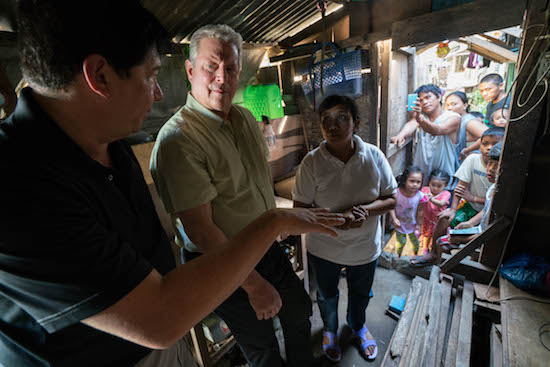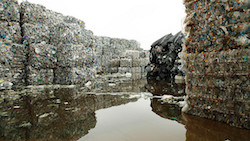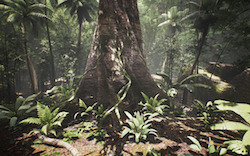SEJournal Online is the digital news magazine of the Society of Environmental Journalists. Learn more about SEJournal Online, including submission, subscription and advertising information.
 |
|
Former Vice President Al Gore appears in "An Inconvenient Sequel: Truth to Power." |
Feature: Sundance Festival a Megaphone for Climate Concerns
By JoAnn M. Valenti
The Sundance Film Festival’s mantra this year — “connect to the environment through story”— reflected its first-ever spotlight on a particular theme, that of climate change. The subject was heralded by some 14 documentaries and short films from among the 188 selected for screening, as well as by panels and virtual-reality experiences.
The Jan. 19-29 annual event was otherwise marked by white-out mountain weather, a cyberattack on the festival’s ticketing system and impassable traffic jams as 46,000 film enthusiasts vied for space in a town of 8,000. Oh, and a snow-bound march timed to demonstrations in Washington, D.C. following the swearing in of a president who famously tweeted that climate change was a “hoax” perpetrated by the Chinese.
“We don’t play advocacy.
We support the storytellers.”
— Sundance Institute founder Robert Redford
Sundance Institute founder Robert Redford, who has long been vested in the environmental movement, maintained that the event was not political but a means for support for filmmakers’ stories, whatever the focus. “I approach film like a journalist,” he said at an opening press conference in describing documentaries as an ever-more important approach to long-form journalism. “We don’t play advocacy. We support the storytellers.”
But the theme’s intent could not have been clearer. Opening night featured former Vice President Al Gore in a follow-up on his crusade for attention to climate change, a new documentary called “An Inconvenient Sequel: Truth to Power.”
The documentary, being distributed by Paramount Pictures, is as much a bio of Gore, his global travels to promote his slide show and recruit climate leaders worldwide, as it is a reinforcement tool for supporters.
In spite of the dire evidence presented, he offered a positive message. “This movie gives me hope for transforming systems and ways of thinking,” Gore said at the festival. Despair is just another form of denial, he asserted, adding “We’re going to win this; no one can stop it. … The will to act is itself a renewable resource.”
Docs on coral reefs, recycling and rural America
 |
| A still from "Plastic China," which documents conditions at a Chinese recycling site. Photo: Courtesy of Sundance Institute | Image by Jiu-liang Wang |
Meanwhile, “Chasing Coral,” which offers dramatic footage of reefs vanishing around the world while divers, photographers and scientists seek answers, was the winning film in The New Climate program. The project was among 32 projects supported by the Sundance Institute. Crowds were also drawn to a six-minute virtual-reality experience showing bleaching on the Great Barrier Reef.
Two others of the theme films presented were also among the Institute-supported projects.
One was “Plastic China,” which documented conditions for workers, including children, at a Chinese recycling site. The second was “Look and See: A Portrait of Wendell Berry.” Redford was among the producers for this 80-minute, unscripted, unrehearsed documentary exposing the unsettling of America’s farm culture, more machines and fewer farmers. Renowned author/poet Berry bemoans shifting values and changing landscapes in rural America often overlooked, he says, by media.
Other theme entries introduce generally unrecognized environmental heroes. “Rancher, Farmer, Fisherman” moves from Montana to Kansas and finally to the Gulf Coast to tell the stories of often overlooked conservationists fighting overdevelopment, using no-till systems to preserve healthy soil and working to sustain fish populations threatened by unregulated recreational fishing. Narrated by Tom Brokaw, the documentary will air on the Discovery Channel in August.
TV shows, virtual reality also featured
The Canadian-produced doc “Rise” was among the several television shows to debut at the festival. It focuses on indigenous peoples’ resistance in the 21st Century and will be part of a Viceland series. Three episodes screened at festival, one on a fight between Arizona tribes and a mining company, and two focused on the oil pipeline standoff at the Standing Rock Sioux Reservation in North Dakota.
 |
| A still from the virtual-reality experience "Tree." Photo: Courtesy of Sundance Institute | Image by Jakob Kudsk Steenson |
“Water & Power: A California Heist” exposes water barons taking advantage of state laws and systems engineered to benefit industry and that leave small farmers and citizens to face a severe water crisis and drought. National Geographic Channel will air “California Heist” later this year.
“Trophy” shines a spotlight on big game hunters and the industry involved in controversial breeding and conservation practices. The balanced doc attempts to examine animals as commodities for the wealthy versus conserving endangered species via legal breeding and controlled sales.
Three short films completed the themed program. “The Diver,” a 16-minute film, follows a worker repairing pumps in a Mexican sewer system loaded with garbage. “Visions of an Island,” at 15 minutes, explores a threatened Alaskan island in the center of the Bering Sea. And the 18-minute “Hot Winter: A Film by Dick Pierre” combines climate change and hardcore porn, albeit edited even for the midnight screenings.
The last — and I thought the best — was a virtual-reality experience called “Tree.” Wearing the obligatory headset and goggles, supplemented with a backpack and standing on a 12- foot-by-12-foot platform, the experience begins by planting a seed.
As you feel movement underfoot and hear rumblings, you — the seed — grow through roots and soil, stretching limbs toward the forest canopy, then watch and listen to tropical wildlife, and cool off with the stars and planets at night, before the scent of fire brings death to the rainforest.
Read more about the festival and presented films at sundance.org.
JoAnn Valenti is an emerita professor and long-time SEJ member who lives in her home state of Florida.
* From the weekly news magazine SEJournal Online, Vol. 2, No. 7. Content from each new issue of SEJournal Online is available to the public via the SEJournal Online main page. Subscribe to the e-newsletter here. And see past issues of the SEJournal archived here.












 Advertisement
Advertisement 



